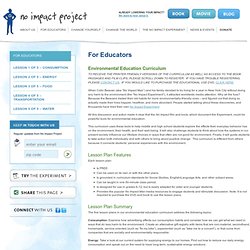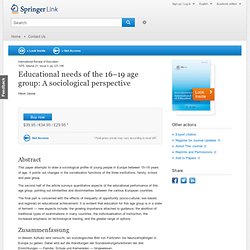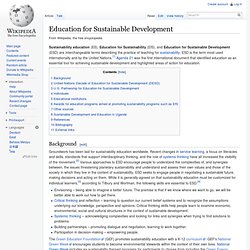

Sustainability education. Diagram of sustainable developmet. Sustainable Energy. Energy is central to sustainable development and poverty reduction efforts.

It affects all aspects of development -- social, economic, and environmental -- including livelihoods, access to water, agricultural productivity, health, population levels, education, and gender-related issues. None of the Millennium Development Goals (MDGs) can be met without major improvement in the quality and quantity of energy services in developing countries. UNDP's efforts in energy for sustainable development support the achievement of: Access to sustainable sources of clean, reliable and affordable energy has a profound impact on multiple aspects of human development; it relates not only to physical infrastructure (e.g. electricity grids), but also to energy affordability, reliability and commercial viability. In practical terms, this means delivering energy services to households and businesses that are in line with consumers' ability to pay.
School Garden Weekly. Summer Bounty Recipes Posted by admin 13 July, 2009 May not be many students around over the summer, but that hasn’t stopped our school gardens from performing.

Corn is high, tomatoes are plump, cucumbers are fat, peppers are turning color, pole beans are still producing, and zucchinis are abundant. cherokee purple tomato Two recipes to utilize all this goodness are included below. Teaching and Learning Resources. Sustainable Development – Earth Charter Initiative. Environment and Sustainability. No Impact Project For Educators » No Impact Project. Environmental Education Curriculum When Colin Beavan (aka “No Impact Man”) and his family decided to try living for a year in New York City without doing any harm to the environment (the “No Impact Experiment”), it attracted worldwide media attention.

Why all the fuss? Because the Beavans traded their old habits for more environmentally-friendly ones – and figured out that doing so actually made their lives happier, healthier, and more abundant. People started talking about these discoveries, and thousands have tried their own No Impact Experiment. All this discussion and action made it clear that the No Impact film and book, which document the Experiment, could be powerful tools for environmental education. This curriculum uses these tools to help middle and high school students explore the effects their everyday behavior has on the environment, their health, and their well-being. Lesson Plan Features Each lesson plan: Lesson Plan Summary Register. UNICEF BT Cotton - Documentary on Child Labour. Schooling the World - Part 1/7. Michael Jackson - Earth song - lyrics. Why Educate for Sustainability? An interview with Jaimie P. Cloud. The Story of Solutions. Education for sustainability. Education for sustainability. Everyday-kindness-around-the-world1.jpg (JPEG Image, 2550 × 3300 pixels) - Scaled (30%)
Sustainable development and education in the digital age. What is the role of education, open education and online communities in sustainable development?

The classical definition of sustainable development is that we should use the global resources only so that the generation coming after us will inherit the planet in as good shape as it was when we were born. We got something from the earlier generations and should past it forward for our children and grant children. Sustainable development is often divided to (1) ecological, (2) economical, (3) social, and (4) cultural sustainability. The different elements of sustainable development are in a close interaction, having an effect on each other. The ecological sustainability means that the ecosystem, the global system as a whole (climate etc.) and all local ecosystems, are protected. In economical sustainable development the growth should be stable and balanced. Reaching cultural sustainability we are not doing much better than with the social sustainability. A simple example. Sustainable-education1.jpg (JPEG Image, 960 × 478 pixels)
EMPOWERED EDUCATION. Fig_1-3.gif (GIF Image, 266 × 261 pixels) Sustainability Frontiers - ‘Go out on a limb… That’s where the blossom grows’ – Tom Forsyth, Isle of Eigg, Inner Hebrides, Scotland * Theme_three.jpg (JPEG Image, 350 × 340 pixels) EfS-Swirl.jpg (JPEG Image, 841 × 595 pixels) Img-main-about.jpg (JPEG Image, 560 × 232 pixels) Education-for-sustainability.jpg (JPEG Image, 560 × 369 pixels) Education Committee 16 19 participation submisssion.pdf. Government Response to consultation on reform of Level 3 vocational qualifications for 16-19 year olds.pdf. Transforming 16 to 19 education and training - the early implementation of 16 to 19 study programmes.pdf.
Educational needs of the 16–19 age group: A sociological perspective. This paper attempts to draw a sociological profile of young people in Europe between 15–19 years of age.

It points out changes in the socialisation functions of the three institutions, family, school and peer group. The second half of the article surveys quantitative aspects of the educational performance of this age group, pointing out similarities and dissimilarities between the various European countries. The final part is concerned with the effects of inequality of opportunity (socio-cultural, sex-based, and regional) on educational achievement. It is evident that education for this age group is in a state of ferment — new aspects include: the growing importance attached to guidance, the abolition of traditional types of examinations in many countries, the individualisation of instruction, the increased emphasis on technological training, and the greater range of options.
In diesem Aufsatz wird versucht, ein soziologisches Bild von Fünfzehn- bis Neunzehnjährigen in Europa zu geben. Responding: Our Role in Education for Sustainable Development. Media as partners in education for sustainable development. Education for Sustainable Development. Sustainability education (ES), Education for Sustainability (EfS), and Education for Sustainable Development (ESD) are interchangeable terms describing the practice of teaching for sustainability.

ESD is the term most used internationally and by the United Nations.[1] Agenda 21 was the first international document that identified education as an essential tool for achieving sustainable development and highlighted areas of action for education. Background[edit] Groundwork has been laid for sustainability education worldwide. Envisioning – being able to imagine a better future. The premise is that if we know where we want to go, we will be better able to work out how to get there.Critical thinking and reflection – learning to question our current belief systems and to recognize the assumptions underlying our knowledge, perspective and opinions. The Green Education Foundation (GEF) promotes sustainability education with a K-12 curriculum.
The objectives of the DESD are to: U.S. The U.S. ESD Toolkit: Web Resources: Education for Sustainable Development. Education. Education for Sustainable Development. Images.